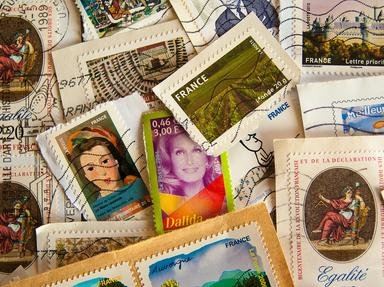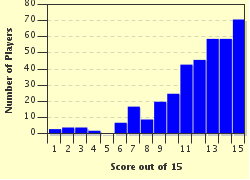Quiz Answer Key and Fun Facts
1. An old postcard turns up and the stamp says, "Eire", with the outline of an island country in the centre, under an arch. The value is indicated as '2', and the dominant colour is green. From what country is this stamp?
2. For your collection, you buy a card of European stamps. One is printed with the name, "Espana", and shows a rather grim looking gentleman in old fashioned clothing; two commemorative dates appear on each side at the top: 1746 and 1828. The stamp is predominantly a reddish orange colour, and the denomination is shown as '50 Cts'. What country issued this stamp?
3. Your parents have gone on holiday to Europe. You receive a postcard from them, on which the stamp is labelled "Sverige". The stamp depicts a father and daughter fishing on a forested lakeside, so it's no surprise to you when your parents write that there are a great number of lakes and forests in what country?
4. Your parents send another postcard; this one is branded "Norge" and the picture shows a traditional fishing boat (square deckhouse aft, high bow) with a harbour behind it, and some very steep hills or mountains rising from the water. From which country did they post this card?
5. You buy a box of old papers at an auction, because there are some old envelopes among them. One has a stamp which bears the name "Deutsches Reich"; it is reddish in colour and has an abstract design but no picture - and the stated denomination is '10 Millionen', which seems to be rather a lot. From what country is this stamp?
6. You discover some letters from your grandparents' tour to Europe on their honeymoon. Two of the stamps mystify you, since they are printed with "Helvetia", and you know of no country in Europe with a name anything like that.
One stamp is brown and shows a man with a crossbow, holding up one arm in a clear command to stop. The denomination is '60', but there is no indication of currency. You resort to a philately reference book, which tells you that these stamps are from which country?
7. In the same box (your grandparents' European honeymoon letters) you find a letter with a stamp which says "Magyar Posta" across the bottom, and also a postcard showing a fortress called "Buda Castle". The stamp is blue, denomination 2.60 'Ft', and depicts a ruined castle in pale shades with a dark outline. The name 'Hollókő' is shown on the top right. From what country do these come?
8. Your grandfather was a mining engineer who worked on copper mines in Southern Africa. You find one of his old letters, and the name on the stamp says, "Northern Rhodesia"; the picture caption is 'Victoria Falls and Railway line'. In the top left is shown inset a young Queen Elizabeth II in profile, and at the lower right Cecil Rhodes (it is a Rhodes centenary issue of 1953). The denomination is 1/2d. What country is this today?
9. You find an unfamiliar stamp in a box labelled 'Far East'; the stamp has a picture showing a youngish man wearing a high-collared tunic and old-fashioned round reading glasses. The country's name is printed in a strange script, both curly and angular, and, in Western print, "Siam". What is this country's name now?
10. An old letter from Southern Africa yields an interesting red stamp from the "Bechuanaland Protectorate"; it shows a naval officer in portrait, and the stamp is headlined, 'Royal Visit 1947', and has a denomination of 1d. What is the Bechuanaland Protectorate called now?
11. From your box of antique papers comes another envelope, this one with a stamp of a greyish-green colour. The upper 3/4 is devoted to a rural view, framed and headed 'Bregenz'; across the bottom is printed, in larger letters, "OESTERREICH", and the denomination is '100 Kronen'. To what country did this stamp belong?
12. On the envelope of a letter to an English tea merchant, you find a stamp in two shades of green with the name "Ceylon"; the picture caption is 'Adam's Peak', and an oval inset on the upper right holds a nobleman's head. The denomination is 3c. What is Ceylon's name today?
13. Another old letter from your mining grandfather has a stamp from "South West Africa" on it, with a picture of a sailing ship and a Portuguese explorer's cross on the coast, and, according to the postmark, was posted from a place called Windhoek. The stamp is an engraved bicolor, red framed with grey centre, in a denomination of 1d. What is the modern name of 'South West Africa'?
14. You buy a packet of mixed stamps to expand your collection. One is quite old, and seems to be a nice find. It's from the "Gold Coast"; it's another engraved bicolor (red and grey) and illustrates two black people 'breaking cocoa pods'. The denomination is 1 shilling (British currency), and the oval inset at upper right holds a young Queen Elizabeth II in profile. What's the Gold Coast called now?
15. Another discovery in the mixed packet is a stamp labelled "British Guiana". This is another engraved bicolor, green with red centre, showing a peasant holding up an enormous fish nearly twice as long as himself; the 'Arapaima'. The denomination is 72 cents, and the young Queen Elizabeth occupies the upper right, surmounted by a crown. How is 'British Guiana' known today?
Source: Author
Rimrunner
This quiz was reviewed by FunTrivia editor
WesleyCrusher before going online.
Any errors found in FunTrivia content are routinely corrected through our feedback system.

